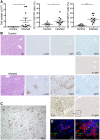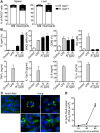Liver Necrosis and Lethal Systemic Inflammation in a Murine Model of Rickettsia typhi Infection: Role of Neutrophils, Macrophages and NK Cells
- PMID: 27548618
- PMCID: PMC4993389
- DOI: 10.1371/journal.pntd.0004935
Liver Necrosis and Lethal Systemic Inflammation in a Murine Model of Rickettsia typhi Infection: Role of Neutrophils, Macrophages and NK Cells
Abstract
Rickettsia (R.) typhi is the causative agent of endemic typhus, an emerging febrile disease that is associated with complications such as pneumonia, encephalitis and liver dysfunction. To elucidate how innate immune mechanisms contribute to defense and pathology we here analyzed R. typhi infection of CB17 SCID mice that are congenic to BALB/c mice but lack adaptive immunity. CB17 SCID mice succumbed to R. typhi infection within 21 days and showed high bacterial load in spleen, brain, lung, and liver. Most evident pathological changes in R. typhi-infected CB17 SCID mice were massive liver necrosis and splenomegaly due to the disproportionate accumulation of neutrophils and macrophages (MΦ). Both neutrophils and MΦ infiltrated the liver and harbored R. typhi. Both cell populations expressed iNOS and produced reactive oxygen species (ROS) and, thus, exhibited an inflammatory and bactericidal phenotype. Surprisingly, depletion of neutrophils completely prevented liver necrosis but neither altered bacterial load nor protected CB17 SCID mice from death. Furthermore, the absence of neutrophils had no impact on the overwhelming systemic inflammatory response in these mice. This response was predominantly driven by activated MΦ and NK cells both of which expressed IFNγ and is considered as the reason of death. Finally, we observed that iNOS expression by MΦ and neutrophils did not correlate with R. typhi uptake in vivo. Moreover, we demonstrate that MΦ hardly respond to R. typhi in vitro. These findings indicate that R. typhi enters MΦ and also neutrophils unrecognized and that activation of these cells is mediated by other mechanisms in the context of tissue damage in vivo.
Conflict of interest statement
The authors have declared that no competing interests exist.
Figures










Similar articles
-
GFPuv-Expressing Recombinant Rickettsia typhi: a Useful Tool for the Study of Pathogenesis and CD8+ T Cell Immunology in R. typhi Infection.Infect Immun. 2017 May 23;85(6):e00156-17. doi: 10.1128/IAI.00156-17. Print 2017 Jun. Infect Immun. 2017. PMID: 28289147 Free PMC article.
-
Cytotoxic effector functions of T cells are not required for protective immunity against fatal Rickettsia typhi infection in a murine model of infection: Role of TH1 and TH17 cytokines in protection and pathology.PLoS Negl Trop Dis. 2017 Feb 21;11(2):e0005404. doi: 10.1371/journal.pntd.0005404. eCollection 2017 Feb. PLoS Negl Trop Dis. 2017. PMID: 28222146 Free PMC article.
-
Persisting Rickettsia typhi Causes Fatal Central Nervous System Inflammation.Infect Immun. 2016 Apr 22;84(5):1615-1632. doi: 10.1128/IAI.00034-16. Print 2016 May. Infect Immun. 2016. PMID: 26975992 Free PMC article.
-
Macrophages make me sick: how macrophage activation states influence sickness behavior.Psychoneuroendocrinology. 2011 Nov;36(10):1431-40. doi: 10.1016/j.psyneuen.2011.07.002. Epub 2011 Aug 19. Psychoneuroendocrinology. 2011. PMID: 21855222 Free PMC article. Review.
-
The Impact of Liver Failure on the Immune System.Int J Mol Sci. 2024 Sep 1;25(17):9522. doi: 10.3390/ijms25179522. Int J Mol Sci. 2024. PMID: 39273468 Free PMC article. Review.
Cited by
-
Vaccine Design and Vaccination Strategies against Rickettsiae.Vaccines (Basel). 2021 Aug 12;9(8):896. doi: 10.3390/vaccines9080896. Vaccines (Basel). 2021. PMID: 34452021 Free PMC article. Review.
-
In silico construction of a multi-epitope vaccine (RGME-VAC/ATS-1) against the Rickettsia genus using immunoinformatics.Mem Inst Oswaldo Cruz. 2025 Mar 21;120:e240201. doi: 10.1590/0074-02760240201. eCollection 2025. Mem Inst Oswaldo Cruz. 2025. PMID: 40136144 Free PMC article.
-
Pathogenic, but Not Nonpathogenic, Rickettsia spp. Evade Inflammasome-Dependent IL-1 Responses To Establish an Intracytosolic Replication Niche.mBio. 2021 Feb 22;13(1):e0291821. doi: 10.1128/mbio.02918-21. Epub 2022 Feb 8. mBio. 2021. PMID: 35130729 Free PMC article.
-
Touching Base with Some Mediterranean Diseases of Interest from Paradigmatic Cases at the "Magna Graecia" University Unit of Infectious Diseases: A Didascalic Review.Diagnostics (Basel). 2023 Sep 1;13(17):2832. doi: 10.3390/diagnostics13172832. Diagnostics (Basel). 2023. PMID: 37685370 Free PMC article. Review.
-
Traditional Chinese medicines and natural products targeting immune cells in the treatment of metabolic-related fatty liver disease.Front Pharmacol. 2023 Jun 9;14:1195146. doi: 10.3389/fphar.2023.1195146. eCollection 2023. Front Pharmacol. 2023. PMID: 37361209 Free PMC article. Review.
References
-
- Sekeyova Z, Roux V, Raoult D. Phylogeny of Rickettsia spp. inferred by comparing sequences of 'gene D', which encodes an intracytoplasmic protein. Int J Syst Evol Microbiol. 2001;51(Pt 4):1353–60. Epub 2001/08/09. . - PubMed
-
- Rathi N, Rathi A. Rickettsial infections: Indian perspective. Indian Pediatr. 2010;47(2):157–64. Epub 2010/03/17. . - PubMed
MeSH terms
Substances
LinkOut - more resources
Full Text Sources
Other Literature Sources

